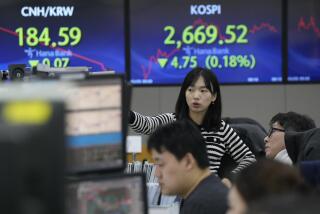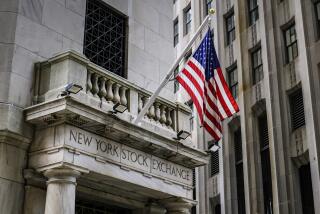Dollar Rises as 5 Central Banks Move to Stop Slide : Expected Drop in Germany’s Discount Rate Also a Factor
NEW YORK — The dollar rose strongly Tuesday after a string of central banks entered the market to support the beleaguered currency, but traders said the outlook remains bearish.
Gold prices fell. At Republic National Bank in New York, gold stood at $488.75 an ounce at 4 p.m. EST, down from $490.25 late Monday.
After hitting postwar lows against most major currencies in overseas trading Monday, the dollar languished in domestic trading, then picked up Monday night as dealers began buying dollars to replace borrowed dollars they had sold earlier, said Marc Chandler, an analyst at Dean Witter Reynolds in Chicago.
When trading opened in Europe, traders said a concerted $500-million intervention by the central banks of Britain, the Netherlands, West Germany, Switzerland and Italy moved the U.S. currency up smartly.
But the dollar fell back from its best levels after dealers, still looking for guidance on where Washington wants the dollar to go, noted the conspicuous absence of the U.S. Federal Reserve from the intervention, the traders said.
Even so, Chandler said, the dollar continued to trade higher when U.S. markets opened, making new session peaks late in the day.
Jean-Marie Eveillard, president of Sogen International Fund, an affiliate of Societe Generale, the large French banking concern, also said traders were riding on the coattails of the central bank buying earlier in the day.
One Frankfurt dealer attributed the dollar’s rise to the usual demand for dollars as the end of the year approaches and accounts need to be reconciled.
Traders said the dollar was also supported by an expectation that West Germany will lower its key discount rate Thursday, a move long advocated by the United States and other trading partners.
In West Germany, financial analysts said the Bundesbank is likely to cut the benchmark discount rate, currently at 3%. The only question, they say, is the size of the reduction. A senior government official hinted that the reduction would be a half a percentage point, taking the rate to its lowest level in history.
West Germany has been under pressure to reduce its interest rates in order to spur growth and help reduce its trade surplus. The Bundesbank announced last week that it was cutting some official rates, but left the discount rate unchanged.
But dealers said the dollar still remained under pressure as long as the United States declined to join its trading partners in supporting the currency.
Chandler said he believed that speculation “was already reflected in current prices.”
In Tokyo, where trading ends before Europe’s business day begins, the dollar fell 0.03 yen to a closing 132.42 yen. Later in London, it traded at 133.05 yen, before rising to 133.40 in New York, where it had traded at 132.23 late Monday.
In London, the dollar gained against the British pound. One pound cost $1.8225, compared to $1.8335 late Monday. It also gained in New York, with a pound costing $1.8095, cheaper than Monday’s $1.8275.
Other late dollar rates in New York, compared to late Monday, were: 1.6570 West German marks, up from 1.6380; 1.3557 Swiss francs, up from 1.3437; 1.3129 Canadian dollars, up from 1.3095; 5.6320 French francs, up from 5.5655 and 1,220.00 Italian lire, up from 1,208.80.
Other late dollar rates in Europe, compared to late Monday, were: 1.6525 West German marks, up from 1.6354; 1.3520 Swiss francs, up from 1.3430; 5.6145 French francs, up from 5.5632; 1.8580 Dutch guilders, up from 1.8400; 1,218.75 Italian lire, up from 1,208.80 and 1.3133 Canadian dollars, up from 1.3075.
The dollar’s fluctuations caused nervous and erratic trading in gold, which ended little changed in London but registered sharper losses elsewhere in Europe.
The metal fell in London to a late bid price of $492.30 an ounce, compared to late Monday’s $492.50.
In Zurich, gold closed at a bid $489.50 compared to $493.00 late Monday.
Earlier, in Hong Kong, gold fell $1.66 to close at a bid $487.85.
At the New York Commodity Exchange, gold sold for $490.40 an ounce, down from $491.
Silver bullion fell on the London market where the metal was trading at a late bid price of $7.05 an ounce, compared to Monday’s $7.09. On the Comex, silver slipped to $6.927, down from $7.037 an ounce late Monday.
More to Read
Inside the business of entertainment
The Wide Shot brings you news, analysis and insights on everything from streaming wars to production — and what it all means for the future.
You may occasionally receive promotional content from the Los Angeles Times.









